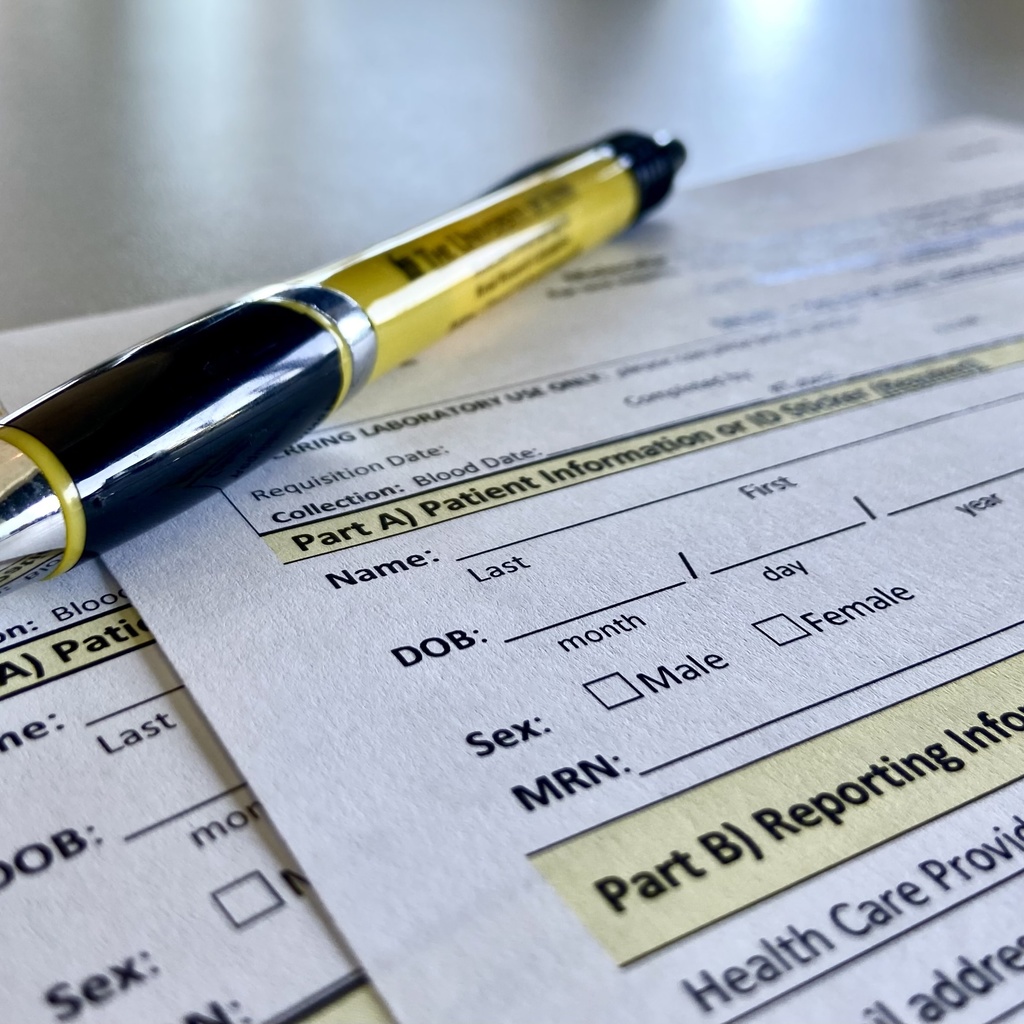MORL Screening Methodology
Sanger sequencing of GJB2, targeted deletion screening for del(GJB6-D13S1830) and del(GJB6-D13S1854) using PCR and gel electrophoresis.
Sample Requirements
(SEND ONLY ONE OF THE FOLLOWING SAMPLE TYPES) :
- 5µg DNA suspended in ≥ 50µl elution buffer
- minimum concentration 50ng/µl
- A260/A280 1.8-2.0
- 3-5 cc EDTA Whole Blood
- room temperature
- Saliva
- DNA Genotek, ORAGene Discover, OGR-500
- Buccal Swabs
- at least 4 swabs
- DNA Genotek, OraCollect, OCD-100
Sample Stability
- Whole Blood Sample Stability for DNA extraction
- EDTA Whole Blood is stable for 7 days at room temperature and 4 months in the refrigerator
- Saliva Collection Kits and Buccal Swabs Sample Stability
- Per the manufacturer for samples collected following the instructions provided with kit/swabs: OGR-500 saliva collection kits are stable at room temperature for several years and OCD-100 buccal swabs stable up to 80 days. Both of these kits can be shipped at room temperature.
Shipping Requirements
- Labeled with the sample type AND patient’s name, DOB, MRN and sex
- Room temperature (DO NOT FREEZE)
- Samples may be refrigerated if delivery is delayed
- Shipping and receiving dock closed on weekends and holidays
- Deliveries accepted Monday - Friday
Provide a pedigree, audiograms, clinic notes regarding hearing loss and temporal bone imaging studies (if performed).

Quick Facts and Information
- CPT Codes: 81252, 81254
- Test Code: GJB2_6
- Turnaround time: 4 weeks
- Cost: $525
Information about GJB2, GJB6, DFNB1
Background Information - GJB2/GJB6
GJB2-related autosomal recessive non-syndromic hearing loss is the most common genetic cause of congenital severe-to-profound non-progressive sensorineural hearing loss in many populations worldwide. This type of hearing loss can also be mild to moderate and is usually stable, though it can progress over time.
Information about DFNB1
Over 97% of the identified variants at the DFNB1 locus occur in exon 2 of GJB2 (Van Camp, et al 2005).We have adopted a tiered screening process focusing first on exon 2 of GJB2 and the two GJB6-containing deletions. The finding of two deafness-causing variants is consistent with the diagnosis of hearing loss at the DFNB1 locus. If only one variant is found, variant screening for the splice site variant in exon 1 of GJB2 (IVS1 + 1 G>A) is completed. If no deafness-causing variants are found, the diagnosis of hearing loss at the DFNB1 locus is excluded based on today’s standards.(OMIM#: 220290)
Two different genes cause hearing loss at this locus, which maps to chromosome 13q11-q12:GJB2, encoding Connexin 26; and GJB6, encoding Connexin 30.
Information about GJB2
(encodes Connexin 26, CX26)
CX26 (OMIM#: *121011) is a gap junction protein expressed in the supporting cells of the cochlea. The gene, GJB2, contains 2 exons, the second of which encodes the 226 amino acid protein CX26. Variants in GJB2 are found in ~50% of persons with autosomal recessive nonsyndromic hearing loss. Over 100 different variants have been identified.
Information about GJB6
(encodes Connexin 30, CX30)
CX30 (OMIM#: *604418) is also a gap junction protein. Lerer and colleagues identified a deletion upstream of GJB2, which included the first exon of GJB6 in 2001. Del Castillo and colleagues characterized this deletion as a 342kb fragment of chromosome 13 that included D13S1830 in addition to a portion of GJB6, and so this deletion is commonly known as the del(GJB6-D13S1830) variant. It cosegregates with variants in GJB2 to cause recessively inherited deafness at the DFNB1 locus. A recent multicenter study investigating the variant spectrum in over 1500 deaf persons from 16 countries found this variant to represent 1.67% of variants at the DFNB1 locus (Van Camp, et al. 2005). A second smaller deletion, del(GJB6-D13S1854), also causes deafness at the DFNB1 locus.
Sensitivity
Sensitivity is greater than 98%.
References
-
Kelsell, D. P. et al.: Connexin 26 mutations in hereditary non-syndromic sensorineural deafness. Nature 387: 80-83, 1997. PubMed ID: 9139825
-
Del Castillo, I. et al.: A deletion involving the connexin 30 gene in nonsyndromic hearing impairment. New Eng. J. Med. 346: 243-249, 2002. PubMed ID: 11807148 Del Castillo, I. et al.: Prevalence and evolutionary origins of the del(GJB6-D13S1830) mutation in the DFNB1 locus in hearing-impaired subjects: a multicenter study. Am J Hum Genet. 2003 Dec;73(6):1452-8. Epub 2003 Oct 21. PubMed ID: 14571368
-
Azaiez,H.et al.: GJB2: The spectrum of deafness-causing allele variants and their phenotype. Human Mutation 2004 Oct;24(4):305-11. PubMed ID: 15365987
-
Del Castillo, F. J. et al.: A Novel Deletion Involving the Connexin-30 Gene, del(GJB6-D13S1854), Found in trans with Mutations in the GJB2 Gene (Connexin-26) in Subjects with Autosomal Recessive Non-Syndromic Hearing Impairment. J Med Genet 2005; 42: 588-594. PubMed ID: 15994881
-
Snoeckx, R. L. et al.: GJB2 Mutations and Degree of Hearing Loss: A Multicenter Study. Am J Hum Genet. 77:945-957, 2005. PubMed ID: 16380907
The Clinical Diagnostics Service of the Molecular Otolaryngology and Renal Research Laboratories is a Joint Commission-approved CLIA-accredited diagnostic laboratory.
